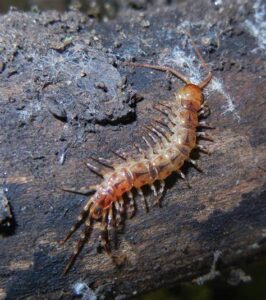Question
What is the correct order of arthropod groups, from those with the most legs to those with the fewest legs?
A arachnids → crustaceans → insects → myriapods
B arachnids → insects → myriapods → crustaceans
C myriapods → crustaceans → arachnids → insects
D myriapods → insects → arachnids → crustaceans
▶️Answer/Explanation
C
The correct order, from the arthropod group with the most legs to the group with the fewest legs, is Myriapods→Crustaceans→Arachnids→ Insects.
Myriapods: Myriapods include centipedes and millipedes. They are characterized by having numerous legs along the length of their bodies. Centipedes typically have one pair of legs per body segment and can have a variable number of legs depending on the species. Millipedes, on the other hand, have two pairs of legs per body segment and can have a significantly higher number of legs.
Crustaceans: Crustaceans are a diverse group of arthropods that includes animals such as crabs, lobsters, shrimps, and barnacles. Most crustaceans have five or more pairs of legs. For example, crabs have ten legs, with the front two pairs modified as pincers, while shrimps and lobsters have ten legs, with the first three pairs serving as claws.
Arachnids: Arachnids include spiders, scorpions, ticks, and mites. They typically have four pairs of legs, totaling eight legs. This is a defining characteristic of arachnids, distinguishing them from other arthropod groups. Although some arachnids may have lost legs or have modified appendages, the basic body plan includes eight legs.
Insects: Insects form the largest and most diverse group of arthropods. They are characterized by having three pairs of legs, totaling six legs. Insects include creatures such as ants, bees, beetles, butterflies, flies, and many others. This group of arthropods is the only one among the four mentioned that has six legs as their typical limb arrangement.
Question
What is a correct way of naming a species using the binomial system?
A Homo sapiens
B Homo Sapiens
C human being
D sapiens
▶️Answer/Explanation
A
The correct way of naming a species according to the binomial system is option A: Homo sapiens.
The binomial system of nomenclature, also known as the Linnaean system, was developed by Swedish botanist Carl Linnaeus in the 18th century. It is a standardized method for naming species in which each species is given a two-part Latin name consisting of a genus name (capitalized) and a species name (lowercase). The genus name is a broader category that groups closely related species together, while the species name is unique to each particular species within the genus.
In the case of humans, “Homo” represents the genus, and “sapiens” is the species name. It is important to capitalize the genus name (Homo) and use lowercase for the species name (sapiens) when writing the scientific name of a species. These names are usually written in italics when printed or underlined when handwritten.
Question
The diagram shows a pea pod, which is a fruit.

Use the key to identify the fruit.
1 sepals fall off as soon as the flower is fertilised ………………………. go to 2
sepals do not fall off as soon as the flower is fertilised …………….. go to 3
2 pod contains fewer than four seeds ………………………………………. A
pod contains more than four seeds ……………………………………….. B
3 fruit splits to release several seeds ……………………………………….. C
fruit splits to release only one seed ……………………………………….. D
▶️Answer/Explanation
C
In a pea Plant (Pisum sativum), sepals do not fall off as soon as the flower is fertilised rather their residues are present in a mature pea pod (also known as a fruit). The mature pea pod undergoes a process known as dehiscence, where it splits open along specific seams. This splitting allows the pod to release several seeds contained within. So option C is correct, fruit splits to release several seeds.
Question
The diagram shows how Homo sapiens (modern people) could have evolved from earlier
ancestors.

Which statement about modern people and their ancestors is correct?
A They are in the same species and the same genus.
B They are in the same species but not the same genus.
C They are in the same genus but not the same species.
D They are neither the same species nor the same genus.
▶️Answer/Explanation
C
According to the diagram, Homo sapiens (modern people) are shown to have evolved from earlier ancestors, including Homo heidelbergensis, Homo erectus, and Homo habilis. In binomial nomenclature, the first word is the genus and the second is species. In the above example, while they are all part of the genus Homo, each represents a different species within that genus. The diagram does not provide any information suggesting that they are all part of the same species.
Question
The diagram shows an insect.

▶️Answer/Explanation
B
Based on the description provided, the insect referred here is Lice.
Lice are small, wingless insects that infest the hair, feathers, or fur of humans and animals. They have short legs relative to their body size and are adapted for clinging to their host’s hair or feathers. Lice are ectoparasites, meaning they live on the outside of their hosts and feed on blood or other bodily fluids.
Question
Using the binomial system of naming organisms, the name of the lion is Panthera leo.
Which statement is correct?
A The lion belongs to the kingdom Panthera.
B The lion belongs to the genus Panthera.
C The lion belongs to the species Panthera.
D The lion belongs to the genus leo
▶️Answer/Explanation
B
In the binomial system, developed by Carl Linnaeus in the 18th century, each species is given a unique two-part scientific name to facilitate clear and standardized communication across different languages and scientific disciplines.In this system, the first part of the name represents the genus to which the species belongs, and the second part indicates the specific epithet or species name. The combination of these two names forms the binomial or scientific name. In the case of Panthera leo, “Panthera” represents the genus and “Leo” is the species within the Panthera genus.The genus Panthera belongs to the family Felidae, which includes the big cats. The genus Panthera is unique in that it comprises the four largest and most powerful members of the cat family. These species are the lion (Panthera leo), tiger (Panthera tigris), leopard (Panthera pardus), and jaguar (Panthera onca).
Question
The diagram shows an animal.
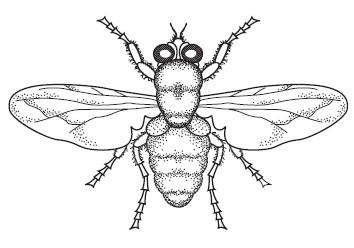
Use the key to identify the animal.
1 wings present …………………………………. go to 2
wings absent ………………………………….. go to 3
2 one pair of wings visible …………………… A
two pairs of wings visible ………………….. B
3 three pairs of legs ……………………………. C
four pairs of legs ……………………………… D
▶️Answer/Explanation
A
The diagram shows a house fly (Musca domestica), which is a common insect known for its small size and oval-shaped body measuring about 6 to 7 millimeters in length. The house fly has one pair of transparent wings that are an important feature for its ability to fly. Each wing is membranous and veined, allowing for efficient flight maneuvers. The wings are attached to the thorax, the middle segment of the fly’s body. The visible pair of wings on the house fly exhibits characteristic venation. The veins form a network of intricate patterns, providing structural support and enabling the fly to achieve stable flight. The wing veins also contain sensory organs that help the fly perceive its surroundings. It’s worth noting that the house fly’s wings beat at an astonishing rate of around 200 times per second, which is what creates the distinctive buzzing sound associated with their flight.
Question
The diagram shows a fish.
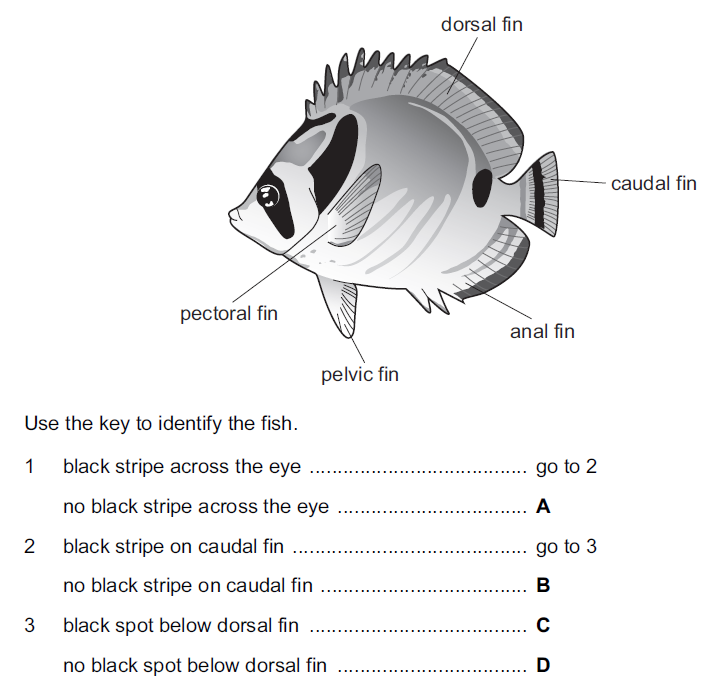
▶️Answer/Explanation
C
Bluegill fish (Lepomis macrochirus) belong to the sunfish family (Centrarchidae). The bluegill fish typically has a dark greenish-blue to olive-colored body with a yellowish-white belly. They have a flattened body shape with a relatively small mouth and a single dorsal fin. One of the notable features of the bluegill fish is a black stripe or band that runs horizontally along the caudal fin. This black stripe is usually well-defined and extends from one end of the fin to the other. It provides a contrast to the overall body coloration and helps in distinguishing bluegill fish from other sunfish species. There is also a black spot located just below the dorsal fin, which is the fin on the fish’s back. This black spot is usually round or oval-shaped and can vary in size, but it is typically small and distinct.
These black stripe on the caudal fin and black spot below the dorsal fin are important identifying features of the bluegill fish.
Question
The diagram shows an animal whose scientific name is Falco peregrinus.
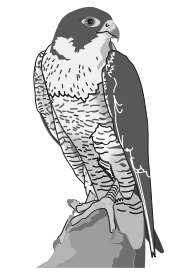
To which species does it belong?
A bird
B F. peregrinus
C Falco
D vertebrate
▶️Answer/Explanation
B
Falco peregrinus (Peregrine Falcon) is a bird of prey and belongs to the species F. peregrinus and the family Falconidae. It is a widespread bird of prey found on all continents except Antarctica. The peregrine falcon is known for its incredible speed and agility, making it one of the fastest birds in the world. It is highly adapted for hunting and is known for its spectacular hunting dives, or “stoops,” which can reach speeds over 240 miles per hour (386 kilometers per hour).
Question
Use the key to identify the arthropod shown.

1 body divided into segments ……………………………… go to 2
body not divided into segments ………………………… go to 3
2 body has one pair of legs per segment ……………… A
body has two pairs of legs per segment ……………..B
3 one pair of antennae ……………………………………….C
two pairs of antennae ………………………………………D
▶️Answer/Explanation
A
Based on the key provided, the arthropod is a centipede. Centipedes belong to the class Chilopoda and are characterized by their long, segmented bodies. Each segment typically has one pair of legs, although some species may have variations in the number of legs per segment. Centipedes are predatory arthropods known for their venomous bites and active hunting behavior. They are commonly found in soil, leaf litter, and other damp habitats.
Question
Which animal is not an arthropod?
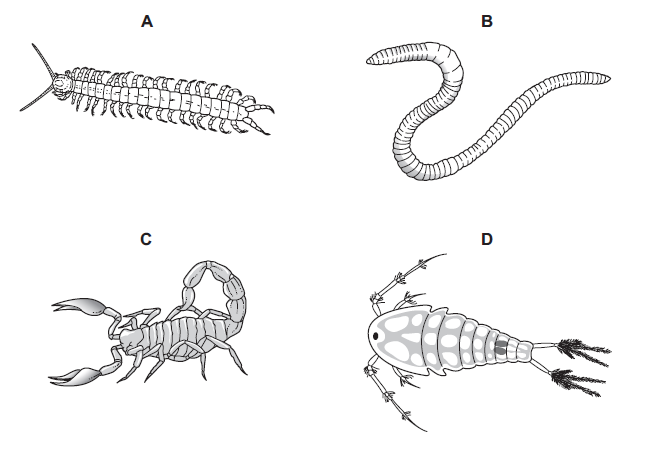
▶️Answer/Explanation
B
Earthworms do not belong to the Arthropods group. They are terrestrial invertebrates that belong to the phylum Annelida and class Clitellata. They are commonly found in soil and play a crucial role in soil health and ecosystem processes. They have long, slender bodies segmented into numerous rings called segments which help them move and perform various functions.
On the other hand, Arthropods are a large and diverse group of invertebrate animals that include insects, spiders, crustaceans (such as crabs and shrimp), millipedes, centipedes, and others. They are characterized by having jointed limbs, a segmented body, and an exoskeleton made of chitin.
Question
The diagram shows an animal found in fresh water.
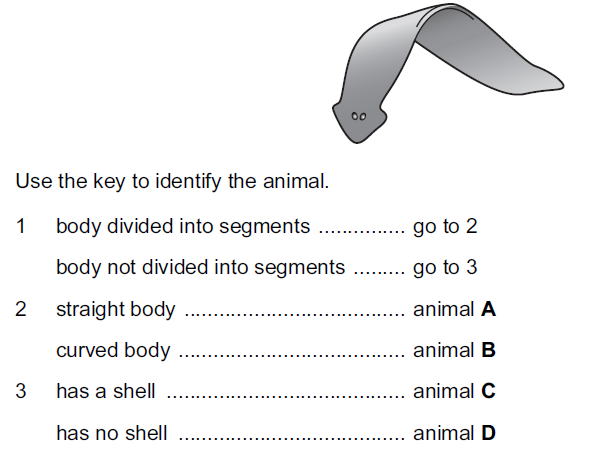
▶️Answer/Explanation
D
The diagram shown here is of Planaria, belonging to the class Turbellaria, a free-living flatworm that exhibits distinct bilateral symmetry. They have a soft, flat body with a triangular head and a tapering tail. The body is usually elongated and can range in size from a few millimeters to several centimeters. Planaria are commonly found in freshwater environments such as ponds, rivers, and streams. They can also be found in moist terrestrial habitats like damp soil or under decaying leaves. They have regenerative abilities. If a planarian is cut into pieces, each fragment has the potential to regenerate into a complete organism.
Question
The diagram shows an animal.
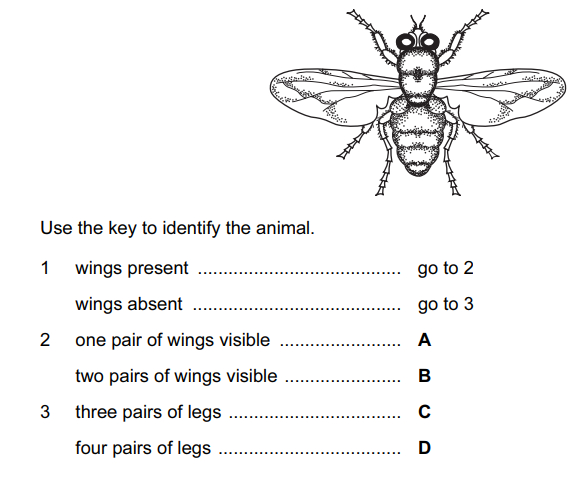
▶️Answer/Explanation
A
The diagram shows a house fly (Musca domestica), which is a common insect known for its small size and oval-shaped body measuring about 6 to 7 millimeters in length. The house fly has one pair of transparent wings that are an important feature for its ability to fly. Each wing is membranous and veined, allowing for efficient flight maneuvers. The wings are attached to the thorax, the middle segment of the fly’s body. The visible pair of wings on the house fly exhibits characteristic venation. The veins form a network of intricate patterns, providing structural support and enabling the fly to achieve stable flight. The wing veins also contain sensory organs that help the fly perceive its surroundings. It’s worth noting that the house fly’s wings beat at an astonishing rate of around 200 times per second, which is what creates the distinctive buzzing sound associated with their flight.
Question
What is a correct way of naming a species, according to the binomial system?
A Homo sapiens
B Homo Sapiens
C human being
D sapiens
 Answer/Explanation
Answer/Explanation
A
Option A is the correct way of naming a species according to the binomial system: Homo sapiens. The binomial system of nomenclature, also known as the Linnaean system, was developed by Swedish botanist Carl Linnaeus in the 18th century. It is a standardized method for naming species in which each species is given a two-part Latin name consisting of a genus name (capitalized) and a species name (lowercase). The genus name is a broader category that groups closely related species together, while the species name is unique to each particular species within the genus. In the case of humans, represents the genus, and is the species name. It is important to capitalize the genus name and use lowercase for the species name when writing the scientific name of a species. These names are usually written in italics when printed or underlined when handwritten
Question
The key can be used to distinguish between four different chemical substances.
Use the key to identify which substance could be a protein.
1 contains the element carbon ……………………………………. go to 2
does not contain carbon …………………………………………..A
2 contains the element nitrogen …………………………………..B
does not contain nitrogen ……………………………………….. go to 3
3 gives a positive result with Benedict’s test ………………….C
gives a negative result with Benedict’s test ……………….. D
▶️Answer/Explanation
B
Proteins are complex organic compounds that are essential for various biological processes. They are composed of long chains of amino acids, which are organic molecules containing carbon, hydrogen, oxygen, nitrogen, and sometimes sulfur.
Since proteins are organic compounds, they must contain carbon, the second criterion is that the substance should contain the element nitrogen. Nitrogen is an essential element found in proteins because amino acids, the building blocks of proteins, contain nitrogen in their chemical structure. Nitrogen is necessary for the formation of peptide bonds between amino acids, which creates the protein’s primary structure.
Based on these criteria, a substance that meets both conditions—contains carbon and nitrogen—could be a protein.
Question
The picture shows an animal.
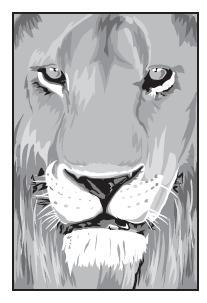
What is the name of this animal according to the binomial system?
A catus
B male African lion
C Panthera leo
D top African carnivorous cat
▶️Answer/Explanation
C
The name of the animal according to the binomial system is Panthera leo. The binomial system is used to give each species a unique two-part name based on its genus and species. In the case of Panthera leo, “Panthera” is the genus name, and “leo” is the species name. The genus Panthera includes large cats, such as lions, tigers, leopards, and jaguars. The species name “leo” specifically refers to the lion.
Question
Keys are used in biological identification.
Which statement may appear in a key and alone could identify one of the plants in the diagrams?
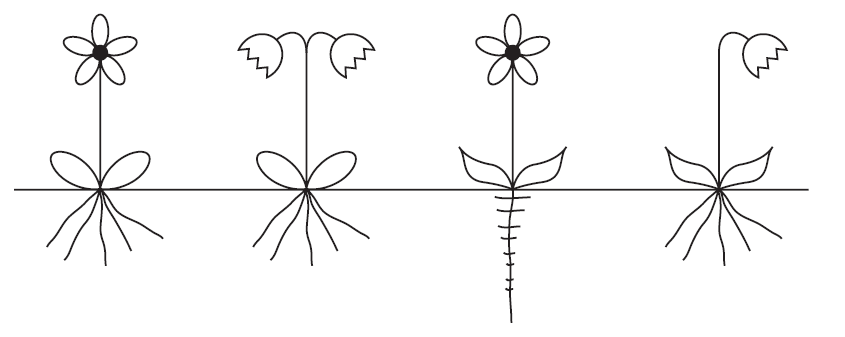
A The plant has a single deep root with small branches.
B The plant has many similar roots, arising from a single point.
C The plant has one flower on the stem.
D The plant has pointed leaves.
▶️Answer/Explanation
A
The third plant in the diagrams has a single deep root with small branches. This plant has a taproot system in which plants develop a primary, deep-rooted structure known as the taproot, from which smaller lateral branches or secondary roots may extend. This type of root system is common in many plants, including trees like oaks, carrots, and dandelions. The taproot grows vertically downwards into the soil, while the smaller lateral branches or secondary roots may spread horizontally or diagonally from the main root. This deep root system helps anchor the plant firmly in the ground and allows it to access water and nutrients from deeper soil layers.
Question
The diagram shows an animal. .
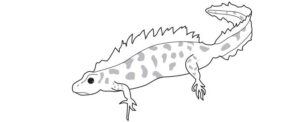
Use the key to identify the animal.
1 front limbs with five fingers ………………….. go to 2
front limbs with four fingers …………………. go to 3
2 skin with spots …………………………………… A
skin without spots ………………………………. B
3 tail with fins ……………………………………….. C
tail without fins …………………………………… D
▶️Answer/Explanation
C
The crested newt, also known as the great crested newt (Triturus cristatus), is a species of amphibian that belong to the family Salamandridae. It has a robust body, reaching lengths of around 15 centimeters. It has a dark-colored back with a warty texture and a bright yellow or orange underside. Like most amphibians, crested newts have limbs with digits or fingers. The forelimbs typically have four toes or fingers, which they use for grasping and movement on land. The tail of the crested newt is flattened and elongated, and it is equipped with a fin-like structure on either side. These fins are more pronounced in males during the breeding season and are used for propulsion in water.
Question
The list shows the scientific names for eight animals, using the binomial system.
Alderia modesta
Arenicola cristata
Arenicola marina
Austrominius modestus
Bittium reticulatum
Botrylloides leachii
Botryllus schlosseri
Clypeostoma reticulatum
Which two animals are most closely related?
A Alderia modesta and Austrominius modestus
B Arenicola cristata and Arenicola marina
C Bittium reticulatum and Clypeostoma reticulatum
D Botryllus schlosseri and Botrylloides leachii
▶️Answer/Explanation
B
The two animals that are most closely related Arenicola cristata and Arenicola marina (option B), are two species of marine worms commonly known as lugworms or sandworms. They belong to the family Arenicolidae and are found in sandy or muddy habitats along the coastlines of Europe and other parts of the world.They both belong to the same genus, Arenicola, which indicates a close evolutionary relationship. The specific epithet (species name) may vary, but the shared genus suggests a more recent common ancestor compared to the other options.
Question
The diagram shows a flower seen from above.
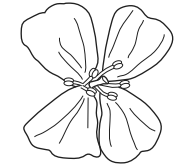
Use the key to find the name of the family to which it belongs.
1 four petals ……………………………………….. go to 2
five petals ……………………………………….. go to 3
2 two stamens ……………………………………. A Scrophulariaceae
six stamens …………………………………….. B Brassicaceae
3 petals joined …………………………………….C Caryophyllaceae
petals separate …………………………………D Rosaceae
▶️Answer/Explanation
Ans: B
The diagram represents a flower from the family Brassicaceae, which is also known as the mustard family or cabbage family. It is a large family of flowering plants that includes several well-known species such as cabbage, broccoli, radish, and mustard. The flower in the diagram has four petals, which is a characteristic feature of many plants in the Brassicaceae family. Four petals arranged in a cross shape, hence the name “cruciferous.” This arrangement is also known as the “cruciform” pattern. These petals are arranged in radial symmetry, meaning they are evenly spaced around the center of the flower. The flowers of Brassicaceae plants are usually small to medium-sized and can be white, yellow, pink, or purple in color. They are typically bisexual, meaning they have both male and female reproductive parts within the same flower.
Question
What is a correct way of naming an organism using the binomial system?
A Common buttercup
B ranunculus acris
C Ranunculus acris
D Ranunculus sp.
▶️Answer/Explanation
C
The binomial system, also known as binomial nomenclature, is a scientific naming system used to assign unique names to organisms. It was developed by Carl Linnaeus and is widely used in biology. The correct way of naming an organism using the binomial system involves two parts: the genus and the species epithet. The genus is a broader category that groups closely related species together, while the species epithet identifies a specific species within the genus. Together, the genus and species epithet form the scientific name of the organism. In the case of, Ranunculus acris, “Ranunculus” is the genus name, and “acris” is the species name. The genus name is always capitalized, while the species name is written in lowercase. Additionally, the entire binomial name is italicized when typed or underlined when written by hand.
Question
The diagram shows a leaf.
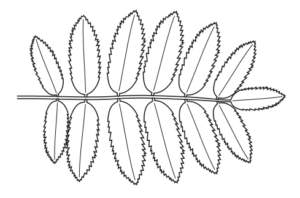
Use the key to identify the plant to which the leaf belongs.
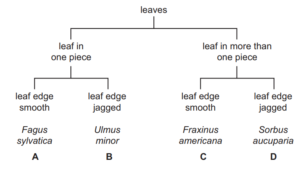
▶️Answer/Explanation
D
Sorbus aucuparia, commonly known as rowan or mountain ash, is a deciduous tree species that belongs to the family Rosaceae. It is native to the cool temperate regions of Europe, including the British Isles, Scandinavia, and parts of Asia. Rowan trees are medium-sized, typically reaching a height of 10 to 20 meters and they are often found in upland areas, mountain slopes, and forests. They have an upright, columnar, or oval-shaped crown. The leaves of the rowan tree are pinnate, meaning they consist of multiple leaflets arranged along a central axis. Each leaf is composed of 9 to 15 pairs of leaflets, which are lanceolate in shape and have serrated margins. The leaves have a dark green color in summer and often turn shades of yellow, orange, or red in autumn.
Question
Use the key to identify the animal shown in the diagram.
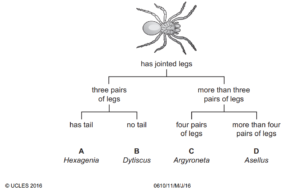
▶️Answer/Explanation
C
Argyroneta is a genus of spiders commonly known as the diving bell spiders or water spiders. They build these bell-shaped structures using silk and air bubbles, which they trap around vegetation or other objects in their aquatic environment.These diving bells serve as both a shelter and a place to store air for breathing. They possess four pairs of legs, with each leg adapted for different functions. These legs are equipped with specialized hairs and claws that allow the spider to move both on land and in water. The front legs are typically used for capturing prey and manipulating objects, while the other pairs aid in movement and maintaining balance. Argyroneta spiders primarily prey on small aquatic insects and other invertebrates, which they capture and store in their diving bells for later consumption.
Question
The diagram shows an insect.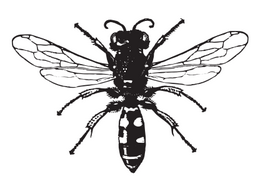
Use the key to identify the insect.
1 wings present ……………………………………. go to 2
wings absent …………………………………….. A
2 two pairs of wings ………………………………. go to 3
one pair of wings ……………………………….. B
3 wings with circular markings ………………… C
wings without circular markings ……………. D
▶️Answer/Explanation
D
The insect in diagram is Wasp from the order Hymenoptera, which includes bees and ants as well. Wasps have two pairs of wings one pair of larger front wings and one pair of smaller hind wings. The two pairs of wings are attached to the thorax, with the forewings being larger than the hindwings. Wasps typically do not have circular markings on their wings. However, the wing veins of wasps may have distinct patterns and markings that can vary among different species. These patterns are often used by entomologists to identify and classify different types of wasps.
Question
The diagram shows part of a flowering plant.

Using the key, identify this plant.
1 three petals …………………………………………. go to 2
more than three petals …………………………. go to 3
2 leaves longer than they are wide ……………. A
leaves wider than they are long ……………… B
3 leaves parallel-veined …………………………… C
leaves not parallel-veined ……………………… D
▶️Answer/Explanation
D
Plant having more than three petals and leaves that are not parallel-veined, it potentially belong to the dicotyledonous group of flowering plants. Dicot plants typically have flower parts in multiples of four or five, including petals, sepals, and stamens. The veins on their leaves are usually reticulated or branching.
Question
The diagram shows an animal.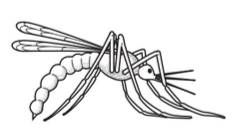
What is the animal?
1 animal with a vertebral column ………………………………… vertebrate
animal with an exoskeleton …………………………………….. go to 2
2 no distinct head, thorax and abdomen ……………………… A
distinct head, thorax and abdomen ………………………….. go to 3
3 eye occupies less than one third of the head …………….. B
eye occupies more than one third of the head ……………. go to 4
4 wings are wider than they are long …………………………… C
wings are longer than they are wide …………………………. D
▶️Answer/Explanation
B
Mosquitoes are small insects that belong to the order Diptera, that typically have three main body segments: the head, thorax, and abdomen. The head of a mosquito is usually smaller in size compared to the thorax and abdomen. The head consists of various structures, including the eyes, antennae, mouthparts, and sensory organs. Mosquitoes have compound eyes, which are made up of multiple individual lenses called ommatidia. These compound eyes provide mosquitoes with a wide field of vision, allowing them to detect movement and locate potential hosts.
The thorax is the middle section of the mosquito’s body and is responsible for housing the wings and legs. It plays a crucial role in the mosquito’s flight and movement.The abdomen is the posterior section of the mosquito’s body and is usually elongated. It contains the mosquito’s digestive system, reproductive organs, and other internal structures.
Question
The diagram shows an animal whose scientific name is Falco peregrinus.
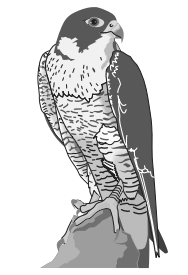
To which species does it belong?
A bird
B F. peregrinus
C Falco
D vertebrate
▶️Answer/Explanation
B
Falco peregrinus (Peregrine Falcon) is a bird of prey and belongs to the species F. peregrinus and the family Falconidae. It is a widespread bird of prey found on all continents except Antarctica. The peregrine falcon is known for its incredible speed and agility, making it one of the fastest birds in the world. It is highly adapted for hunting and is known for its spectacular hunting dives, or “stoops,” which can reach speeds over 240 miles per hour (386 kilometers per hour).
Question
What kind of skin do amphibians have?
A dry without scales
B dry with scales
C moist without scales
D moist with scales
▶️Answer/Explanation
C
Amphibians are a class of vertebrates that include frogs, toads, salamanders, and caecilians. One of the defining characteristics of amphibians is their moist, glandular skin, which lacks scales or feathers. This moist skin is highly permeable, allowing for the exchange of gases, such as oxygen and carbon dioxide, with the environment. It also helps amphibians to stay hydrated and enables them to absorb water through their skin. The lack of scales distinguishes them from reptiles, which have dry, scaly skin.
Question
The diagram shows a flowering plant.

Use the key to identify the plant.
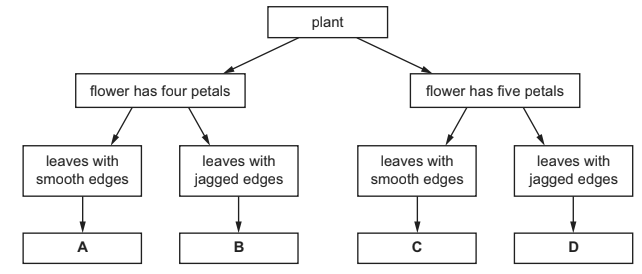
▶️Answer/Explanation
D
The flower of wild roses(genus Rosa) usually have five petals and leaves having jagged edges. Roses are popular and well-known flowering plants that exhibit these characteristics. They have five-petaled flowers that come in various colors and fragrances, and their leaves are typically serrated or have jagged edges. They are widely cultivated for their beautiful and fragrant flowers and are one of the most popular and recognizable flowering plants.
Question
The table shows the scientific names of four members of the cat family.
| common name | scientific name |
leopard lion ocelot tiger | Panthera pardus Panthera leo Leopardus pardalis Panthera tigris |
Which statement is correct?
A All four cats are members of the same species.
B The leopard and the ocelot are members of the same genus.
C The leopard, lion and tiger are members of the same genus.
D The leopard, lion and tiger are members of the same species.
▶️Answer/Explanation
C
Tiger(Panthera tigris), lion (Panthera leo), and leopard (Panthera pardus) are three members of the same genus Panthera from the family Felidae.Within the family Felidae, they belong to the subfamily Pantherinae, commonly known as the “big cats.” Within the genus Panthera, which consists of large cats capable of roaring, there are four recognized species: the lion, tiger, leopard, and jaguar (Panthera onca). These species share common characteristics, such as muscular bodies, sharp retractable claws, and a specialized larynx that allows them to roar
Question
The binomial name for humans is Homo sapiens.
Which row is correct?
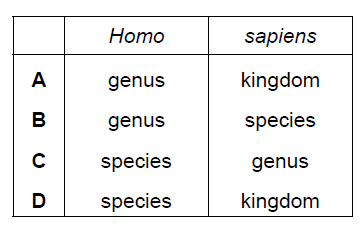
▶️Answer/Explanation
B
Homo is the genus name (capitalized) and sapiens is the species name (lowercase), it is a standardized method for naming species. The genus name is a broader category that groups closely related species together, while the species name is unique to each particular species within the genus. It is important to capitalize the genus name and use lowercase for the species name when writing the scientific name of a species. These names are usually written in italics when printed or underlined when handwritten.
Question
The diagram shows a stonefly larva.
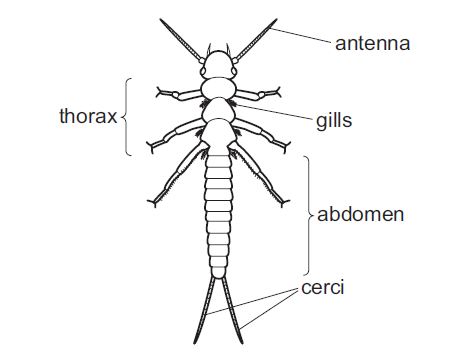
Use the key to identify the stonefly larva.
1 has two cerci at the end of the abdomen …………. go to 2
has three cerci at the end of the abdomen ……….. go to 3
2 abdomen longer than thorax ………………………….. A
thorax longer than abdomen ………………………….. B
3 gills visible on the thorax ……………………………….. C
gills not visible ……………………………………………… D
▶️Answer/Explanation
A
Stoneflies are aquatic insects belonging to the order Plecoptera, and their larvae, known as nymphs, are typically found in freshwater streams and rivers. Stonefly larvae typically have a long, slender and flattened body with 6 sprawling legs and a segmented abdomen bearing 2 long antenna-like “tails” (cerci). The antennae are long, too. Gills are tuftlike and usually positioned at the bases of the legs, on the underside of the body. Each foot has 2 claws.
Question
The scientific names of some animals are listed.
1 Camelus dromedarius
2 Camelus ferus
3 Equus ferus
4 Struthio camelus
Which animals are in the same genus?
A 1, 2 and 3
B 1, 2 and 4
C 1 and 2 only
D 2 and 3 only
▶️Answer/Explanation
C
Both the Camelus dromedarius (dromedary camel) and Camelus ferus (wild Bactrian camel) belongs to genus Camelus. The dromedary camel (Camelus dromedarius), has one back hump, while the wild Bactrian camel (Camelus ferus) have two. They are members of the Camelidae family, which also includes llamas, alpacas, and other camel species. While the dromedary camel has been domesticated for thousands of years and is widespread in many desert regions, the wild Bactrian camel is a rare and endangered species, with only a few hundred individuals remaining in the wild.
Question
Scientists discover a new species of animal.
It has a segmented body with two pairs of legs on each segment.
To which group of animals does this new species belong?
A arachnids
B crustaceans
C insects
D myriapods
▶️Answer/Explanation
D
Based on the description, the new species of animal with a segmented body and two pairs of legs on each segment belongs to group D: myriapods. Myriapods, such as millipedes and centipedes, are characterized by having numerous body segments, each with two pairs of legs. Their bodies are divided into two sections—a head and a trunk. The trunk is further divided into multiple segments, each having a pair of appendages, or legs. Myriapods have a pair of antennae on their head and a pair of mandibles and two pairs of maxillae Arachnids, crustaceans, and insects do not typically possess two pairs of legs on each segment, making myriapods the most suitable group for this particular description.
